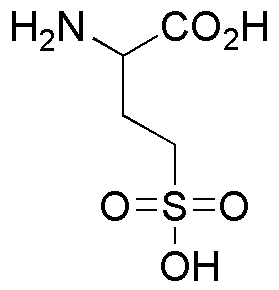DL-Homocysteic acid is widely utilized in research focused on:
- Neuroscience Research: It serves as a potent excitatory amino acid, making it valuable for studying neurotransmission and synaptic plasticity in the brain.
- Pharmaceutical Development: This compound is explored for its potential therapeutic effects in treating neurological disorders, offering insights into drug design and efficacy.
- Metabolic Studies: Researchers use it to investigate metabolic pathways involving sulfur-containing amino acids, helping to understand conditions like cardiovascular diseases.
- Cell Culture Applications: It is employed in cell culture media to promote cell growth and differentiation, particularly in studies involving neuronal cells.
- Biochemical Assays: DL-Homocysteic acid is used in various assays to measure enzyme activity and interactions, providing critical data for biochemical research.
General Information
Properties
Safety and Regulations
Applications
DL-Homocysteic acid is widely utilized in research focused on:
- Neuroscience Research: It serves as a potent excitatory amino acid, making it valuable for studying neurotransmission and synaptic plasticity in the brain.
- Pharmaceutical Development: This compound is explored for its potential therapeutic effects in treating neurological disorders, offering insights into drug design and efficacy.
- Metabolic Studies: Researchers use it to investigate metabolic pathways involving sulfur-containing amino acids, helping to understand conditions like cardiovascular diseases.
- Cell Culture Applications: It is employed in cell culture media to promote cell growth and differentiation, particularly in studies involving neuronal cells.
- Biochemical Assays: DL-Homocysteic acid is used in various assays to measure enzyme activity and interactions, providing critical data for biochemical research.
Documents
Safety Data Sheets (SDS)
The SDS provides comprehensive safety information on handling, storage, and disposal of the product.
Product Specification (PS)
The PS provides a comprehensive breakdown of the product’s properties, including chemical composition, physical state, purity, and storage requirements. It also details acceptable quality ranges and the product's intended applications.
Certificates of Analysis (COA)
Search for Certificates of Analysis (COA) by entering the products Lot Number. Lot and Batch Numbers can be found on a product’s label following the words ‘Lot’ or ‘Batch’.
*Catalog Number
*Lot Number
Certificates Of Origin (COO)
This COO confirms the country where the product was manufactured, and also details the materials and components used in it and whether it is derived from natural, synthetic, or other specific sources. This certificate may be required for customs, trade, and regulatory compliance.
*Catalog Number
*Lot Number
Safety Data Sheets (SDS)
The SDS provides comprehensive safety information on handling, storage, and disposal of the product.
DownloadProduct Specification (PS)
The PS provides a comprehensive breakdown of the product’s properties, including chemical composition, physical state, purity, and storage requirements. It also details acceptable quality ranges and the product's intended applications.
DownloadCertificates of Analysis (COA)
Search for Certificates of Analysis (COA) by entering the products Lot Number. Lot and Batch Numbers can be found on a product’s label following the words ‘Lot’ or ‘Batch’.
*Catalog Number
*Lot Number
Certificates Of Origin (COO)
This COO confirms the country where the product was manufactured, and also details the materials and components used in it and whether it is derived from natural, synthetic, or other specific sources. This certificate may be required for customs, trade, and regulatory compliance.


